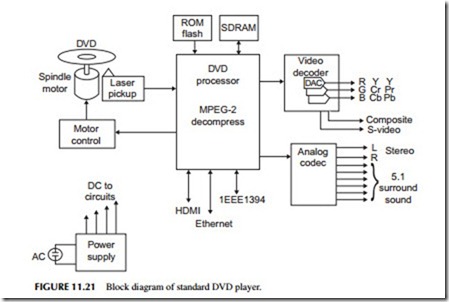DIGITAL VIDEO DISCS
The formal meaning of DVD is digital versatile disc. Its main use is video but it can also store computer data or audio. It is the storage medium of choice for movies, music videos, and other video programming. It has virtually replaced the VCR.
The basic DVD storage medium is a disc that is almost identical to the CD discussed in Chapter 10. The disc is the same size (120-mm diameter), but it is formatted differently to store many more bits and bytes of data. While the CD can store up to about 700 MB, the DVD can store about 4.7 GB, that is, gigabytes or billions of bytes. And that is just the basic one-sided disc. There are also single-side/double-layer discs, double-sided/single-layer, and double- sided/double-layer versions that can store even more, up to 15.9 GB.
The storage method is the same. A laser beam burns pits into a spiral track. The data is represented as pits and lands as described earlier in the CD discus- sion (see Figure 10.6). The big difference is that the size of the pits is signifi- cantly smaller and the track spacing is less than half the CD spacing, that is, 1.6 microns (1600 nanometers) versus 740 nanometers (nm). A nanometer is 1-billionth of a meter. With smaller pits and tighter spacing, the disc can hold significantly more data.
But that is not the whole story. The video is also compressed. Unlike the audio on a CD, which is not compressed, digital video is compressed with the MPEG-2 standard described earlier. This gives roughly a 40-to-1 compression. In that way, a full 2 hours of video can be stored.
As for audio, the format is as described in Chapter 10 for CDs, but DVD audio is Digital Dolby Surround Sound 5.1 using six channels of 16-bit, 44.1-kHz digital sound. Audio DVDs are also available with 192-kHz sampling of the audio with 24-bit ADCs, giving even greater fidelity and low-noise performance.
How a DVD Player Works
Figure 11.21 depicts the block diagram of a typical DVD player. First, note the motor that drives the disc. It is a variable-speed device that changes speeds as the pickup mechanism moves from inside to outside as it reads the spiral track.
The pickup head uses a laser that shines on the disc to read the pits and lands. Because of the closer spacing, a higher-frequency (shorter wavelength) laser is used. CD players use a 780-nm laser, while DVD players use a 640-nm laser that has a smaller focused beam.
The photodetector in the head picks up the laser reflections and sends the 10 Mb/second data stream to the processing chips. In some players, a single- chip application-specific device handles all of the digital processing from demultiplexing, to error detection and correction, decoding, and MPEG-2 decompression. All this may be in separate chips in some players.
In any case, the MPEG-2 data goes to a video decoder and to multiple DACs that re-create the original analog RGB signals. Various video formats are used, such as RGB, YCrCb, and YPrPb, each of which needs three DACs each. Most DVD players also decode regular composite video and S-video.
The separated audio signals go to an audio codec that contains the DACs which recover the audio content either in basic stereo or 5.1 surround sound. As for interfaces, an HDMI output is provided. Most players also have an Ethernet port, IEEE 1394, and USB connections.
Don’t forget that some of the later models are also DVD recorders. They play DVDs but also burn new ones with video from the TV set, cable box, satellite box, or a built-in tuner.
A Word about Blu-ray
Blu-ray is the next generation of DVD medium and players. The discs are the same size but thanks to even smaller pits, lands, and track spacing, even greater storage capacity is available. With 320-nm track spacing and a 405-nm (blue light wavelength) laser, the single-sided disc can hold up to 25 GB of data. That is enough to store two full-length high-definition movies or 13 hours of standard-definition video. A double-layer version is also available that doubles those storage figures. Blu-ray uses MPEG-2 compression, but also supports other video compression standards such as MPEG-4/H.264 and VC-1.

